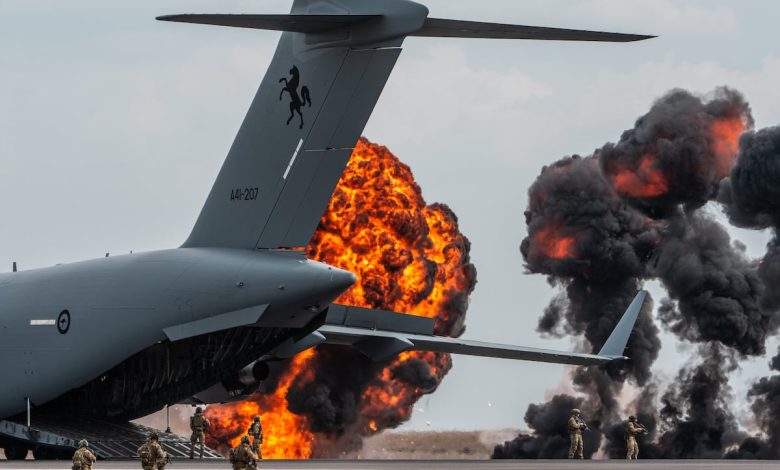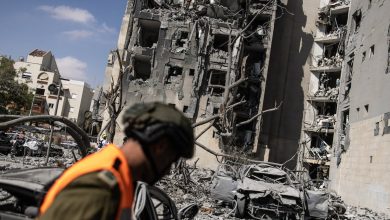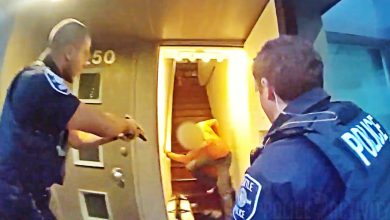Australia sizes up a continent-size gap in air defenses

MELBOURNE, Australia — Australian military leaders are scrambling to cobble together fresh air defense capabilities, as China’s missile arsenal is growing and Beijing’s warships have started showing up in Australasia.
Global companies offered weaponry to that end at the recent Avalon International Airshow, held near Melbourne in late March.
For now it appears that military leaders are prizing sensors over interceptors in what will be Australia’s future network of weapons for defending would-be targets in a conflict.
Air Vice-Marshal Nick Hogan, head of Air Force Capability, acknowledged that an integrated, medium-range air defense capability has been delayed.
“What’s most important to us is seeing and sensing first, so getting the command and control right first, and then getting the kinetics that might be required to effect anything coming towards us,” he told Defense News at the Avalon event.
Hogan was referring primarily to Project Air 6500, which is slowly delivering an integrated air battle management system.
One lesson from Ukraine is the need for air defense, and Hogan said Australia was learning from evolutions seen globally. However, Australia currently owns only NASAMS batteries and three air-warfare destroyers.
While major Australian cities and military bases are often on coasts, there are simply not enough ships to protect them all. Furthermore, it is likely the U.S. will demand an air defense umbrella to protect a nuclear submarine base being established in Western Australia.
The Defence Strategic Review of 2023 urged acceleration of medium-range and high-speed missile defenses, with authors lamenting the low priority placed on integrated air and missile defense.
Instead of “pursuing a long-term, near-perfect solution at unaffordable cost,” the review said the government must allocate “sufficient resources to the Chief of Air Force to deliver the initial capability in a timely way”.
According to Hogan, ground-based defenses may not be the ideal solution for Australia.
“When you have a limited inventory, you want to be able to be as flexible as possible, so that might be using maritime stocks on land, it might be using land stocks in the maritime domain,” he said. “There are many options to go forward. What we’re trying to do is make sure, where possible, we can get the biggest return on investment using sovereign capabilities.”
Asked about a timeline for implementation, Hogan said: “As soon as we can practically make it happen.”
Potential solutions, such as Raytheon’s Patriot and systems from Israel and South Korea, were being promoted at Avalon Airshow 2025.
Officials have also begun addressing an Australian weakness in countering drones, albeit at a limited level.
Last year, Anduril Australia signed a three-year deal to trial a counter-drone capability at RAAF Base Darwin in the north, but this is an isolated step forward.
Nonetheless, Air Marshal Stephen Chappell, Chief of Air Force, said: “We’re investing in our northern base infrastructure,” including “the ability to passively defend, use deception, be able to recover, be able to agilely move forces around”.
Hardened aircraft shelters are no longer part of the equation.
“That was a fantastic concept for its day, but probably its day has passed,” Chappell said.
“We’re already working with our civilian sector and our industry sectors in the northern half of Australia using non-military airfields to land, refuel and, in the future, rearm, combat aircraft or other aircraft in order to regenerate airpower from non-military bases.”
A recent report by the U.S.-based Hudson Institute think tank assessed that as few as ten missiles, each with a warhead spraying cluster munitions over a 450-foot diameter, could neutralize all aircraft parked in the open at various key U.S. bases. Australia’s situation is no different. Likewise, loitering munitions could easily penetrate regular aircraft shelters.
Air Vice-Marshal Glen Braz, Air Commander Australia, argued the air service is “very deliberate about our passive efforts” to protect bases.
“As threats evolve, and warfare evolves, we’d seek to have layers of defense systems that we’d want to have in place,” Braz said. “But we’re very much training our teams to fight the network of bases as a system.”
Meanwhile, officials used the the Avalon airshow to provide an assessment of key aerial platforms in the pipeline.
They had good things to say about the influx of F-35s, the fifth-generation warplane made by Lockheed Martin.
“We had the last nine aircraft arrive in December, so we’re thrilled to have our 72 F-35s with us in Australia across our three operational squadrons, the training unit and integrated training center,” Chappell told Defense News.
Elsewhere, the RAAF continues testing of Boeing Defence Australia’s MQ-28A Ghost Bat unmanned aircraft. Hogan said he is “very pleased” with progress.
“This year we’re going to demonstrate the capabilities of the platform over a number of activities,” Hogan said. “We’ll test all of the payloads we’ve planned for potential use on the platform, with the exception of it being armed. That’s one that remains in our thinking, but we’re going to focus on other payloads first.”
Competition for the Ghost Bat is brewing under Project Air 6015, where the RAAF will make recommendations to government on the way forward for collaborative combat aircraft, probably by year’s end.
Hogan said the MQ-28A will be a “very strong contender in any options we take forward to government.”
Regardless, Anduril believes its YFQ-44A Fury stands a chance. The American company displayed a full-sized model of the aircraft at the Avalon show.
Gordon Arthur is an Asia correspondent for Defense News. After a 20-year stint working in Hong Kong, he now resides in New Zealand. He has attended military exercises and defense exhibitions in about 20 countries around the Asia-Pacific region.







